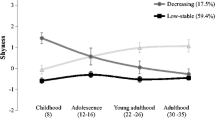Abstract
Objective measures of shyness in the MacArthur Longitudinal Twin Study were obtained in two testing situations: the laboratory and the home. A longitudinal hierarchical model was fitted to the data, allowing estimation of the extent to which genetic, shared environmental, and unique environmental influences contributed to continuity and change of the shyness phenotype from 14 to 20 months of age. The sample consisted of 163 monozygotic and 138 same-sex dizygotic twin pairs. Models were fitted to raw data using a maximum-likelihood pedigree approach. Genetic, shared environmental, and unique environmental first-order factors, with specific variances, were modeled on each of four shyness ratings assessed in the laboratory and home at 14 and 20 months. Four second-order genetic, shared environmental, and unique environmental factors were also modeled. Results indicated that developmental change from 14 to 20 months and situational specificity between the laboratory and the home are mediated largely by shared and unique environmental influences. Genetic variation is largely responsible for both the stability in shyness from 14 to 20 months and the phenotypic correlations observed between the laboratory and the home settings.
Similar content being viewed by others
References
CERN (1977).MINUIT: A System for Function Minimization and Analysis of the Parameter Errors and Correlations, European Organization for Nuclear Research, Geneva, Switzerland.
Emde, R. N., Plomin, R., Robinson, J. A., Reznick, J. S., Campos, J., Corley, R., DeFries, J. C., Fulker, D. W., Kagan, J., and Zahn-Waxler, C. (1992). Temperament, emotion, and cognition at 14 months: The MacArthur Longitudinal Twin Study.Child Dev. 63:1437–1455.
Goldsmith, H. H. (1993). Temperament: Variability in developing emotion systems. In Lewis, M., and Haviland, J. M. (eds.),Handbook of Emotions, Guilford Press, New York, pp. 353–364.
Horn, J. L., McArdle, J. J., and Mason, R. (1983). When is invariance not invariant: A practical scientist's look at the ethereal concept of factor invariance.South. Psychol. 1:179–188.
Hubert, N. C., Wachs, T. D., Peters-Martin, P., and Gandour, M. J. (1982). The study of early temperament: Measurement and conceptual issues.Child Dev. 53:571–600.
Jöreskog, K. G., and Sörbom, D. (1989).LISREL 7: A Guide to the Program and Applications, 2nd ed., SPSS, Chicago.
Kagan, J., Reznick, J. S., and Snidman, N. (1988). Biological bases of childhood shyness.Science 240:167–173.
Lange, K., Westlake, J., and Spence, M. A., (1976). Extensions to pedigree analysis. III. Variance components by the scoring method.Ann. Hum. Genet. 39:485–491.
Matheny, A. P., Jr. (1989). Children's behavioral inhibition over age and across situations: Genetic similarity for a trait during change.J. Personal. 57:215–235.
Matheny, A. P., Jr., and Dolan, A. B. (1975). Persons, situations, and time: A genetic view of behavioral change in children.J. Personal. Soc. Psychol. 32:1106–1110.
Matheny, A. P., Jr., and Wilson, R. S. (1981). Developmental tasks and rating scales for the laboratory assessment of infant temperament.JSAS Catalog Select. Documents Psychol. 11(81):Manuscript No. 2367.
Muthén, B., and Kaplan, D. (1985). A comparison of some methodologies for the factor analysis of non-normal Likert variables.Br. J. Math. Stat. Psychol. 38:171–189.
Neale, M. C. (1994).Mx: Statistical Modeling (2nd ed.), Department of Psychiatry, Medical College of Virginia, Richmond.
Plomin, R., and Daniels, D. (1986). Genetics and shyness. In Jones, W. H., Cheek, J. M., and Briggs, S. R. (eds.),Shyness, Plenum, New York, pp. 63–80.
Plomin, R., and Rowe, D. C. (1979). Genetic and environmental etiology of social behavior in infancy.Dev. Psychol. 15:62–72.
Plomin, R., DeFries, J. C., and Fulker, D. W. (1988).Nature and Nurture in Infancy and Early Childhood, Cambridge University Press, Cambridge.
Plomin, R., Campos, J., Corley, R., Emde, R. N., Fulker, D. W., Kagan, J., Reznick, J. S., Robinson, J., Zahn-Waxler, C., and DeFries, J. C. (1990). Individual differences during the second year of life: The MacArthur Longitudinal Twin Study. In Columbo, J., and Fagan, J. (eds.),Individual Differences in Infancy: Reliability, Stability, & Predictability, Lawrence Erlbaum Associates, Hillsdale, NJ, pp. 431–455.
Plomin, R., Emde, R. N., Braungart, J. M., Campos, J., Corley, R., Fulker, D. W., Kagan, J., Reznick, J. S., Robinson, J., Zahn-Waxler, C., and DeFries, J. C. (1993). Genetic change and continuity from fourteen to twenty months: The Macarthur Longitudinal Twin Study.Child Dev. 64: 1354–1376.
Robinson, J. L., Kagan, J., Reznick, J. S., and Corley, R. (1992). The heritability of inhibited and uninhibited behavior: A twin study.Dev. Psychol. 28:1030–1037.
Stevenson, J., and Fielding, J. (1985). Ratings of temperament in families of young twins.Br. J. Dev. Psychol. 3:143–152.
Author information
Authors and Affiliations
Rights and permissions
About this article
Cite this article
Cherny, S.S., Fulker, D.W., Corley, R.P. et al. Continuity and change in infant shyness from 14 to 20 months. Behav Genet 24, 365–379 (1994). https://doi.org/10.1007/BF01067538
Received:
Accepted:
Issue Date:
DOI: https://doi.org/10.1007/BF01067538




